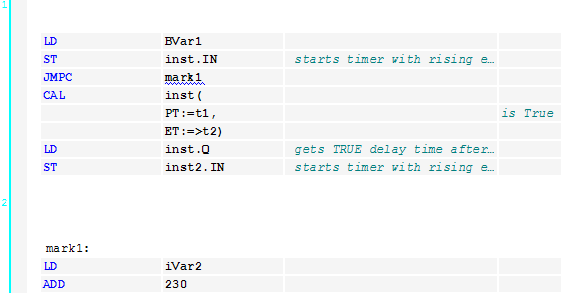The instruction list is an assembler-like IEC 61131-compliant programming language.
It supports accumulator-based programming.
An instruction list (IL) consists of a series of instructions. Each instruction starts in a new line and contains an operator and, depending on the type of operation, one or more operands separated by commas.
A label, followed by a colon, can be placed in front of an instruction. It serves the identification of the instruction and you can use the label as a jump destination.
A comment must be the last element in a line. Empty lines can be inserted between instructions.
All IEC 61131-3 operators are supported, as are multiple inputs, multiple outputs, negations, comments, set/reset of outputs and conditional/unconditional jumps.
Each instruction is based primarily on the loading of values into the accumulator
(LD instruction). After that the corresponding operation is executed with the parameter
from the accumulator. The result of the operation is written again into the accumulator,
from where you should store it purposefully with the help of an ST instruction.
The instruction list supports comparison operators (EQ, GT, LT, GE, LE, NE) and jumps
for programming of conditional executions or loops. Jumps can be unconditional (JMP)
or conditional (JMPC / JMPCN). In the case of conditional jumps, a check is performed
as to whether the value in the accumulator is TRUE or FALSE.
Example






